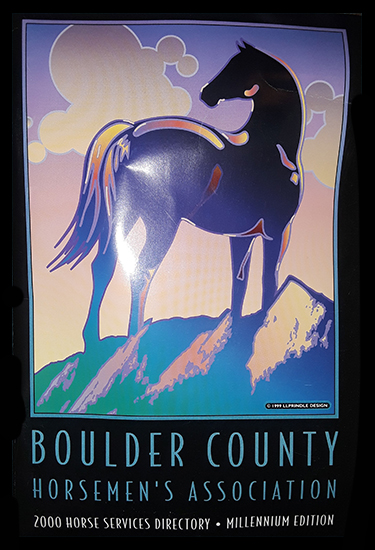
Against all odds—or so it seemed at the time—the Boulder County Horsemen’s Association (BCHA) survived Y2K. BCHA delivered itself safely into the first decade of a new millennium as a freshly minted 501(c)(3) nonprofit organization. Shortly thereafter, in a nod to more progressive times ahead, a minor name change reflected major cultural shifts when the organization’s name was changed to Boulder County Horse Association.
The new millennium launched with a standing room only crowd at the BCHA’s annual meeting in February 2000. At that time 17 members graced the board. Suzanne Webel was at the helm as President, with Judd Adams, Margaret Lewis and Cathy Swanson in various VP roles. At the meeting:
- Mary Midkiff and Margot Nacey presented Fit to Ride: Body & Mind
- The annual achievement award was presented to local equine veterinarian Dr. Nancy Loving
- The gorgeously glossy millennium edition of the BCHA Horse Services Directory was distributed
Notable trends of the BCHA Horse Services Directory showed:
- 9 listings for acupuncture/herbal medicine/massage and chiropractic
- 9 listings for Natural Horsemanship (including Tai Chi for Horsemen)
- 5 listings for equine supplements and vitamins
- A whopping 10 listings for ‘horse therapy’
Horses and the New Millennium in Boulder County
In the years 2000–2003:
- The Colorado Horse Rescue moved to its current location on 65th Street in Longmont
- Local hay cost only $4/bale (but the price was beginning to be unsustainable for some farmers growing and harvesting it)
- Mounted Search & Rescue was in full swing in collaboration with the Boulder County Sheriff’s Office
- BCHA launched its website in 2003
- The West Nile Virus landed in the western U.S. prompting numerous clinics, seminars and newsletter articles
Drought and Fires
The Overland Fire started on October 29th, 2003 near Jamestown. In just the one day, with high winds blowing across the Colorado Front Range, the fire burned 3,500 acres and destroyed 12 homes.
“The day started out unusually hot and dry for October 29th. 80 degrees at 7 AM! A great day for one of our traditional BCHA Wednesday rides, and we were planning to go up to the mountains for one last high-country exploration before winter. Then the winds picked up and started blowing with gale force county-wide. Well, there’s not much that makes me cancel a ride, but I sure hate riding in the wind, so we decided that discretion was the better part of valor and agreed to stay home.”
Thankfully, after safe evacuations of horses and residents, including all at the Autumn Hill Boarding Facility, the winds died down and a cold, wet front came in to help put the fire out.
Fire came raging through our backyard again in 2009 with two fires breaking out on January 7th. More than 200 horses were evacuated during the Olde Stage and Neva Road fires which grew rapidly due to dry, wind-driven conditions. The Olde Stage Fire burned approximately 3,400 acres. About 300 acres of Joder Arabian Ranch’s (JAR) 350 acres were burned but incredibly no structures or livestock were lost. It was noted that JAR had been diligent about fire mitigation for years and had an excellent emergency preparedness plan in place.
Education
BCHA’s bi-monthly newsletter, The Horse’s Mouth, morphed into a full-fledged multi-page magazine. This was the heyday of print, which seeming hit an apex in the latter part of the first decade of the new millennium before going digital forever. The issues were chock full of diverse educational material. Here’s just a tiny example:
- Horse Trekking in India
- Dressage
- Trailer Loading
- Emergency Evacuations
- Plant Poisoning in Times of Drought
- Breeding and Foaling
- Polo and Endurance Riding
Many of the articles grew out of the year-round clinics and seminars sponsored by BCHA, with regular articles by local veterinarians.
Collaboration was key to BCHA’s approach through the decade. The brochure, Sharing Trails Safely with Horses, grew out of shared efforts between other key trail user groups including, perhaps surprisingly, off-road vehicles. In 2004, the brochure, Colorado’s Poisonous Menace: Do you know what your horse is eating? was generously funded by the Colorado Horse Development Authority, now known as the Colorado Horse Council. This statewide promotional and marketing organization was a mere five years old at the time. The brochure is still available today for purchase from BCHA.
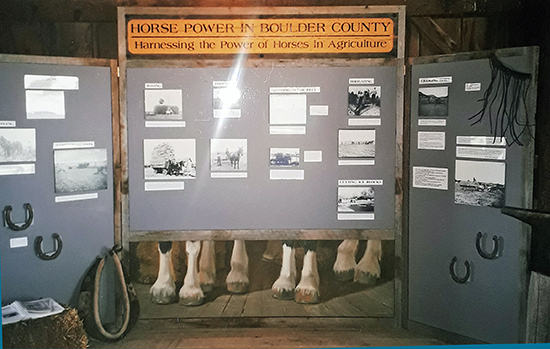
Lohr/McIntosh Agricultural Heritage Center
The educational display, Horse Power in Boulder County (shown above), was created by a BCHA committee of volunteers. It was an an important educational resource illustrating the role of draft horses in agriculture in early Boulder County. The exhibit stood for many years at the Lohr/McIntosh Agricultural Heritage Center in Longmont.
In 2004, this travelling educational booth made its way to the Cowboy Poetry Festival in Estes Park, the Boulder County Fair, and the Boulder Creek Festival where it was shared with the Boulder Off-Road Alliance, and the Boulder Area Trails Coalition (BATCO). More examples of the collaborative spirit of the day.
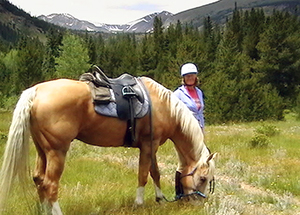
Recreation
An amazing thing started circa 1996 when mounted explorer Suzanne Webel started leading weekly Wednesday BCHA trail rides in Boulder County. They lasted for more than 25 years, through fire and ice, hail and brimstone. Following these adventures was her newsletter column Happy Trails. The column evolved into a compendium of four volumes with full descriptions, maps, photos, illustrations and essays.
Horse Lover’s Fling
Throughout the decade, the annual BCHA Horse Lover’s Fling became the primary fundraising vehicle for BCHA. Is was was an event of great anticipation, requiring lots of planning and volunteer effort. The third annual Horse Lover’s Fling took place in spring 2000 featuring keynote speakers Temple Grandin and the late Marty Marten. The event raised more than $6,000. It was noted to be almost three times more than the previous year. By 2006 the 10th annual Fling was attended by about 250 people. Flings of the day included a silent auction, seated or buffet dinner, educational displays and presentations, dancing and live music.
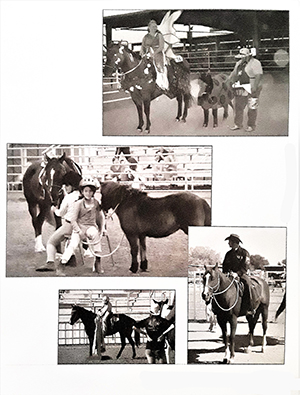
The BCHA Fun Show
By the dawn of the new millennium the annual BCHA Fun Show already had an ardent following. As one newsletter put it, “There is plenty of camaraderie at the BCHA Fun Show. It’s an opportunity to see old friends and make new ones. You also see we all have more work to do to convince our horses to do things right!”
The fun classes were the most popular starting with Egg and Spoon. Other favorites included Bareback Dollar, the Champagne Class, and the Coke Race (as in Coca Cola). By 2009 the Fun Show had 110 entries in 15 different classes with demonstrations of Miniature Horse Driving and Medieval Horsemanship and Games.
The BCHA Fun Show is still an annual October event and fundraiser for BCHA. We hope to see you at the at the Boulder County Fairgrounds this October!
Legislation
Throughout the first decade of the new millennium, engagement in the public process to ensure equestrian access on city, county, state and U.S. Forest Service trails was a key focus for BCHA’s legislative mission. And what better way to engage with key policy makers than inviting them to get to know a great bunch of enthusiastic horse people, in beautiful open space settings while enjoying lunch and even horseback riding? This is how BCHA’s Public Lands Appreciation Day was born.
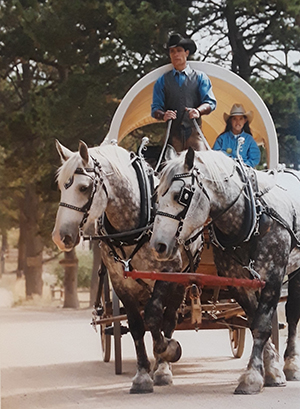 Public Lands Appreciation Day (PLAD)
Public Lands Appreciation Day (PLAD)
BCHA initiated these impactful events in 1999. By September 2000 the ever energetic Mary Midkiff led the charge for a full day event at Gold Lake Resort in western Boulder County. Over 60 BCHA members, public lands officials, VIPs and guests gathered despite the nearby Walker Ranch Fire. Even Boulder Mayor Will Toor was in attendance with his family and enjoyed some trail riding.
PLAD’s stated goal was to help local officials gain a better understanding of horses and the importance of retaining and expanding equestrian access to public lands. Mary Midkiff, who was awarded the BCHA annual achievement award in 2003 put it this way, “BCHA created this special event to provide a friendly, relaxed environment for interaction between public land managers and members of Boulder County’s horse community. The events have been positive and successful in building bridges of communication between horse people and land use officials in Boulder County…the objective is to celebrate and interact with everyone involved in its use.”
In 2005, the event was hosted at Heil Valley Ranch with close to 70 guests. Mary Midkiff wrote:
“More than the fun and games, food and fellowship, I trust that this year we planted seeds of communication and understanding that will bear fruit for years to come. We, the Board of Directors and members of BCHA, appreciate the time you spent with us. We enjoyed….showing you what it is we love about our precious Open Space.”

City of Boulder Open Space and Mountain Parks
In 2000, the City of Boulder recognized BCHA for its active volunteer role in city open space efforts. The relationship continued through the decade including:
- Active involvement in the 2004 OSMP Visitor Plan
- Extensive planning and equestrian advocacy for Eldorado Mountain/Doudy Draw Trails Study Area, West Trail Study Area, Grasslands Ecosystem Management Plan, and Off-Trail Permits
- Expansion of horse trailer access at Doudy Draw and Flatirons Vista Trailheads
- Annual BCHA member trail volunteer days at the Doudy Draw Trail
During the OSMP Visitor Plan process of 2004, much attention focused on the potential for trail user conflicts. But during meetings and in publications BCHA members and leaders stood firm in their support of sharing trails and educating users on good trail etiquette. Ambassadorship was paramount and those efforts were reflected in a stance that embraced rather than ostracized multiple user groups. “We are absolutely in solidarity with mountain bikers,” said then-President Suzanne Webel.

Boulder County Parks and Open Space: Caribou Ranch
There were many county-wide Open Space efforts involving BCHA throughout the decade, but perhaps none is more emblematic of the challenges and rewards than Caribou Ranch. In a years-long process BCHA leaders worked tirelessly to secure equestrian access to Caribou Ranch Open Space.
The path to get where we are today has been winding and at times precipitous. According to the Draft Caribou Ranch Open Space Management Plan released in 2002 the vision for public use of the area, based on wishes of the seller was clear: “Public trails perpetually limited to hiking, cross country skiing, snowshoeing, horseback riding and other pedestrian and equestrian activities.” In other words, no cyclists or off-road vehicles.
Then-seated Boulder County Commissioner Paul Danish published an Open Forum letter in the Daily Camera scathingly critical of members of BCHA working to ensure equestrian access to the property. In response, long-time BCHA member Stuart Creighton was there with his own letter to the Camera. It appears these were fraught times with ever increasing pressure from various open space user groups. In the end, BCHA saw the project through and adopted the DeLonde Trail at Caribou Ranch.
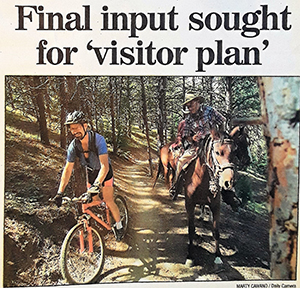
Suzanne Webel summarized it to me this way: “Long story short, it took 10 years off my life—literally, full time—to get [BCPOS] to agree to partially open Caribou Ranch, and another five years to get those trails built. Today if you ride there you will see a tiny sign acknowledging BCHA as having adopted the DeLonde Trail—and it’s still my favorite, not-so-secret place to ride.”
Beyond Boulder County
BCHA was engaged throughout the 2000s at the state and federal level as well including in Eldorado Canyon State Park and US Forest Service lands with ongoing advocacy for equestrian access to Switzerland Trail (Rainbow Lakes) adjacent to Caribou Ranch, Hessie Trailhead and Mt. Thorodin.
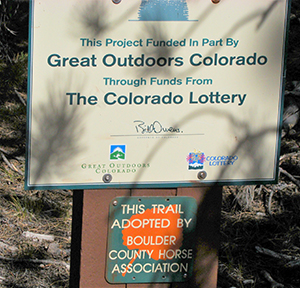
It may be easy to look back on Y2K with nostalgia while forgetting the collective angst most of us felt at the time. In many ways for many people the prospect of falling off the cliff of the known into the abyss of the unknown was very real. Remember those stockpiles of shelf-stable food and toilet paper? In some ways it seems parallel to these times 20 years later. The pandemic and its impacts on all facets of life and its persistence over a year make it unlike anything our generation has experienced before. But BCHA survived Y2K and grew to thrive throughout the first decade of the new millennium. Through community, collaboration, vision, generosity and hard work BCHA solidified a foundation that’s there for us to stand on as we face these current challenges.
[divider style=”solid” color=”#cccccc” opacity=”1″ icon_color=”#666666″ icon_size=”15″ placement=”equal”]
A word from series author, Clare Tone: As a volunteer I devote as much time as I am able to researching the archives, interviewing past leaders and writing these articles. My hope is to honor the past while bringing it alive to inspire future BCHA endeavors. I aim for accuracy while recognizing my knowledge of past events, names and timelines can never be complete. Please forgive me any missteps in the retelling.

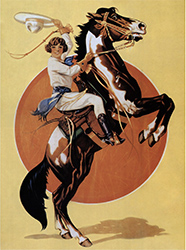 Do you have stories or photos from BCHA’s past?
Do you have stories or photos from BCHA’s past?